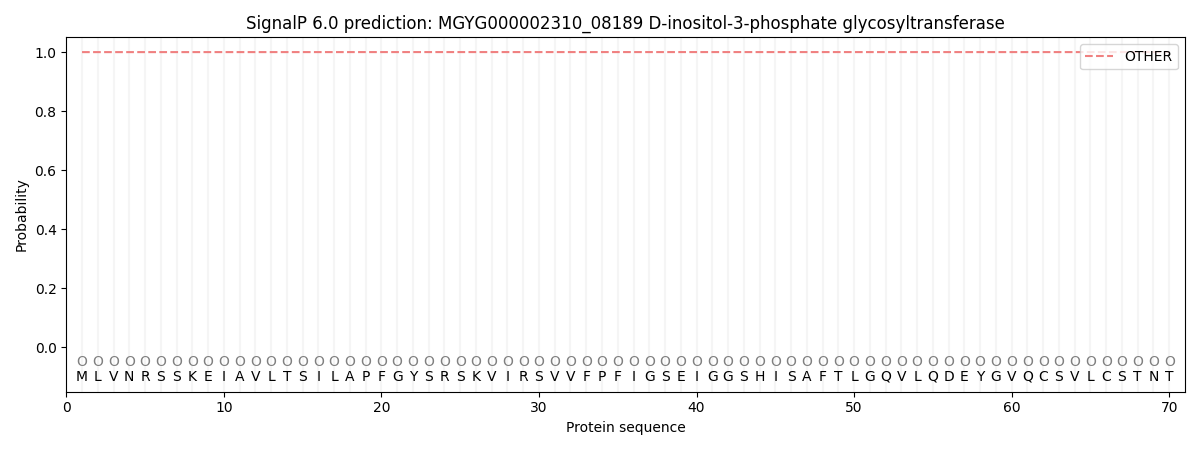You are browsing environment: HUMAN GUT
CAZyme Information: MGYG000002310_08189
You are here: Home > Sequence: MGYG000002310_08189
Basic Information |
Genomic context |
Full Sequence |
Enzyme annotations |
CAZy signature domains |
CDD domains |
CAZyme hits |
PDB hits |
Swiss-Prot hits |
SignalP and Lipop annotations |
TMHMM annotations
Basic Information help
| Species | Microvirga massiliensis | |||||||||||
|---|---|---|---|---|---|---|---|---|---|---|---|---|
| Lineage | Bacteria; Proteobacteria; Alphaproteobacteria; Rhizobiales; Beijerinckiaceae; Microvirga; Microvirga massiliensis | |||||||||||
| CAZyme ID | MGYG000002310_08189 | |||||||||||
| CAZy Family | GT4 | |||||||||||
| CAZyme Description | D-inositol-3-phosphate glycosyltransferase | |||||||||||
| CAZyme Property |
|
|||||||||||
| Genome Property |
|
|||||||||||
| Gene Location | Start: 75588; End: 76796 Strand: - | |||||||||||
CDD Domains download full data without filtering help
| Cdd ID | Domain | E-Value | qStart | qEnd | sStart | sEnd | Domain Description |
|---|---|---|---|---|---|---|---|
| cd03801 | GT4_PimA-like | 1.23e-33 | 31 | 392 | 4 | 366 | phosphatidyl-myo-inositol mannosyltransferase. This family is most closely related to the GT4 family of glycosyltransferases and named after PimA in Propionibacterium freudenreichii, which is involved in the biosynthesis of phosphatidyl-myo-inositol mannosides (PIM) which are early precursors in the biosynthesis of lipomannans (LM) and lipoarabinomannans (LAM), and catalyzes the addition of a mannosyl residue from GDP-D-mannose (GDP-Man) to the position 2 of the carrier lipid phosphatidyl-myo-inositol (PI) to generate a phosphatidyl-myo-inositol bearing an alpha-1,2-linked mannose residue (PIM1). Glycosyltransferases catalyze the transfer of sugar moieties from activated donor molecules to specific acceptor molecules, forming glycosidic bonds. The acceptor molecule can be a lipid, a protein, a heterocyclic compound, or another carbohydrate residue. This group of glycosyltransferases is most closely related to the previously defined glycosyltransferase family 1 (GT1). The members of this family may transfer UDP, ADP, GDP, or CMP linked sugars. The diverse enzymatic activities among members of this family reflect a wide range of biological functions. The protein structure available for this family has the GTB topology, one of the two protein topologies observed for nucleotide-sugar-dependent glycosyltransferases. GTB proteins have distinct N- and C- terminal domains each containing a typical Rossmann fold. The two domains have high structural homology despite minimal sequence homology. The large cleft that separates the two domains includes the catalytic center and permits a high degree of flexibility. The members of this family are found mainly in certain bacteria and archaea. |
| cd03811 | GT4_GT28_WabH-like | 1.28e-27 | 108 | 373 | 76 | 341 | family 4 and family 28 glycosyltransferases similar to Klebsiella WabH. This family is most closely related to the GT1 family of glycosyltransferases. WabH in Klebsiella pneumoniae has been shown to transfer a GlcNAc residue from UDP-GlcNAc onto the acceptor GalUA residue in the cellular outer core. |
| COG0438 | RfaB | 1.16e-25 | 96 | 394 | 90 | 377 | Glycosyltransferase involved in cell wall bisynthesis [Cell wall/membrane/envelope biogenesis]. |
| cd03807 | GT4_WbnK-like | 2.19e-21 | 109 | 392 | 73 | 362 | Shigella dysenteriae WbnK and similar proteins. This family is most closely related to the GT4 family of glycosyltransferases. WbnK in Shigella dysenteriae has been shown to be involved in the type 7 O-antigen biosynthesis. |
| cd03798 | GT4_WlbH-like | 7.62e-20 | 27 | 394 | 2 | 376 | Bordetella parapertussis WlbH and similar proteins. This family is most closely related to the GT4 family of glycosyltransferases. Staphylococcus aureus CapJ may be involved in capsule polysaccharide biosynthesis. WlbH in Bordetella parapertussis has been shown to be required for the biosynthesis of a trisaccharide that, when attached to the B. pertussis lipopolysaccharide (LPS) core (band B), generates band A LPS. |
CAZyme Hits help
| Hit ID | E-Value | Query Start | Query End | Hit Start | Hit End |
|---|---|---|---|---|---|
| QRM33396.1 | 1.07e-162 | 23 | 394 | 8 | 378 |
| ANY78276.1 | 1.66e-147 | 40 | 401 | 1 | 361 |
| ANY78281.1 | 4.19e-100 | 31 | 394 | 12 | 374 |
| QRM33401.1 | 4.19e-100 | 31 | 400 | 12 | 379 |
| ACP22662.1 | 1.14e-42 | 29 | 398 | 7 | 387 |
PDB Hits download full data without filtering help
| Hit ID | E-Value | Query Start | Query End | Hit Start | Hit End | Description |
|---|---|---|---|---|---|---|
| 4N9W_A | 8.61e-07 | 31 | 358 | 9 | 331 | Crystalstructure of phosphatidyl mannosyltransferase PimA [Mycolicibacterium smegmatis MC2 155],4NC9_A Crystal structure of phosphatidyl mannosyltransferase PimA [Mycolicibacterium smegmatis MC2 155],4NC9_B Crystal structure of phosphatidyl mannosyltransferase PimA [Mycolicibacterium smegmatis MC2 155],4NC9_C Crystal structure of phosphatidyl mannosyltransferase PimA [Mycolicibacterium smegmatis MC2 155],4NC9_D Crystal structure of phosphatidyl mannosyltransferase PimA [Mycolicibacterium smegmatis MC2 155] |
| 2GEJ_A | 8.92e-07 | 31 | 358 | 25 | 347 | CrystalStructure of phosphatidylinositol mannosyltransferase (PimA) from Mycobacterium smegmatis in complex with GDP-Man [Mycolicibacterium smegmatis MC2 155],2GEK_A Crystal Structure of phosphatidylinositol mannosyltransferase (PimA) from Mycobacterium smegmatis in complex with GDP [Mycolicibacterium smegmatis MC2 155] |
Swiss-Prot Hits download full data without filtering help
| Hit ID | E-Value | Query Start | Query End | Hit Start | Hit End | Description |
|---|---|---|---|---|---|---|
| Q9R9N1 | 1.29e-09 | 166 | 351 | 122 | 295 | Lipopolysaccharide core biosynthesis glycosyltransferase LpsE OS=Rhizobium meliloti (strain 1021) OX=266834 GN=lpsE PE=3 SV=1 |
| P71053 | 4.74e-07 | 182 | 391 | 172 | 368 | Putative glycosyltransferase EpsD OS=Bacillus subtilis (strain 168) OX=224308 GN=epsD PE=2 SV=1 |
| A0QWG6 | 4.67e-06 | 31 | 358 | 5 | 327 | Phosphatidyl-myo-inositol mannosyltransferase OS=Mycolicibacterium smegmatis (strain ATCC 700084 / mc(2)155) OX=246196 GN=pimA PE=1 SV=1 |
SignalP and Lipop Annotations help
This protein is predicted as OTHER

| Other | SP_Sec_SPI | LIPO_Sec_SPII | TAT_Tat_SPI | TATLIP_Sec_SPII | PILIN_Sec_SPIII |
|---|---|---|---|---|---|
| 1.000048 | 0.000000 | 0.000000 | 0.000000 | 0.000000 | 0.000000 |
